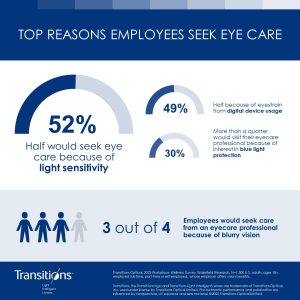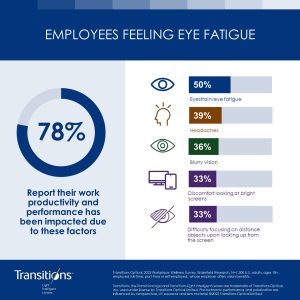Employees Seek Dynamic Light Protection and Premium Vision Plan Benefits for Increased Demands on Their Eyes
BY JONATHAN ORMSBY
With many workers now preferring remote or hybrid work versus a traditional workspace, increased visual demands on employees’ eyes is likely to be an ongoing future of work trend.
According to PEW Research, 60% of workers with jobs that can be done from home say when the COVID-19 outbreak ends, if they have the choice, they’d like to work from home all or most of the time. This is up from 54% who said the same in 2020. Among those who are currently working from home all or most of the time, 78% say they’d like to continue to do so after the pandemic, up from 64% in 2020 (Pew Research Center. “COVID-19 Pandemic Continues to Reshape Work in America.” Feb. 16, 2022. https://www.pewresearch.org/social-trends/2022/02/16/covid-19-pandemic-continues-to-reshape-work-in-america/). As employees continue to prefer to work in remote or hybrid situations, harsh indoor lighting in the workplace, sun glare from increased time spent outdoors and on digital screens may lead to unwanted side effects such as increased exposure to harmful blue light, a rise in digital eyestrain and corresponding symptoms — which may take a toll on vision and may ultimately impact employee productivity and retention.
EMPLOYEES’ EYES ARE IN OVERDRIVE

A recent Transitions Optical survey found that since the beginning of the COVID-19 pandemic, over half of employees report spending more time in front of their computer screens now than in previous years. Among these employees, nearly nine in 10 (85%) are experiencing more digital eye strain — with many also experiencing corresponding symptoms, such as headaches (51%), dry eye (48%), and light sensitivity (29%).
[Transitions Optical, 2021 Workplace Wellness Survey, Wakefield Research, N=1,300 U.S. adults, ages 18+, employed full-time or part-time, whose employer offers vision benefits].
Additionally, 22% of employees report spending more time going outside into bright sunshine now than before the pandemic. [Transitions Optical, Global Consumer Sentiment and Behavior, Multi-country survey (AR, AU, CO, FR, IT, SG, ZA, UK, US), Q4 2020, People Research, N=6,403/N=700 per country. Eyeglasses wearers agree – Top 2 Box responses].
Facing increasing visual demands, employees are becoming more aware of the important role lenses and premium vision plan benefits play in helping to protect and preserve their eye health. According to Transitions Optical’s 2021 Workplace Wellness Survey, one-third of employees are actively seeking out information about blue light eyeglasses, updating their prescription, and/or buying new glasses. Beyond this, many employees are now seeking eyewear solutions, even without considering the financial cost. In Transitions Optical’s latest survey, 86% of employees say they are willing to pay more than their insurance allowance for a new pair of eyeglasses, with 59% saying they are likely to spend $100 or more over their coverage.
Not only that, 96% of employees surveyed say they are also willing to pay above what their insurance fully covers for premium lens options — with more than half (55%) of employees willing to pay more for UV protection. Additionally, nearly half (49%) of employees report they are willing to pay more for blue light protection and 44% are willing to pay above what their insurance fully covers for photochromic lenses.
Photochromic lenses, which adapt to changing light, indoors and out, while helping to offer protection from harmful blue light and ultraviolet rays, continues to influence employee interest in premium vision plans. (“Harmful blue light” is calculated up to 455nm, with the greatest toxicity between 415-455 nm). In fact, 70% of employees say they are much/somewhat more likely, with 44% indicating they are much more likely, to enroll in a vision plan that covers Transitions brand lenses specifically — which block 100% of UVA and UVB rays and help filter harmful blue light indoors and outdoors (Transitions® Signature® GEN 8™ block at least 20% of harmful blue light indoors & over 87% of harmful blue light outdoors except Transitions® Signature® lenses style colors which block over 75% outdoors. “Harmful blue light” is calculated between 380nm and 460nm.)
The survey also found that while almost three out of four employees (73%) would see care from an eyecare professional because of blurry vision, over half (52%) would seek care because of light sensitivity, half (49%) because of eyestrain from digital device usage, and more than a quarter (30%) would visit their eye care professional because of interest in blue light protection.
Eyecare professionals have also taken note of the pandemic’s effect on their patients’ eye health as more than 70% of them agree that their patients have become more sensitive to eye care and protection since the pandemic began. Research from Transitions Optical substantiates this finding, as 75% of consumers surveyed say that lenses should help to protect from both ultraviolet light and harmful blue light.
PREMIUM VISION PLANS BENEFIT EMPLOYEE HEALTH, RETENTION & PRODUCTIVITY
The increased occurrences of light sensitivity and digital eye strain that employees are facing can lead to many problems for employees while at work, ranging from trouble seeing, to headaches, to even taking excessive breaks.
Transitions Optical’s 2022 Workplace Wellness Survey found that 78% of employees report their work productivity and performance has been impacted by either eye strain/eye fatigue (50%), headaches (39%), blurry vision (36%), discomfort looking at bright screens (33%), and/or difficulty focusing on distance objects upon looking up from the screen (33%). Additionally, in 2020, a Transitions Optical survey found 67% of employees take breaks throughout the day to help alleviate discomfort from sitting behind a screen.
The silver lining? Premium eyewear options, often covered in full or in part by vision benefits plans, can help to alleviate symptoms — further boosting employee wellness and productivity, while improving an employer’s bottom line.
It’s also important to note that annual comprehensive eye exams, typically included in a vision benefits plan, not only identify common problems with vision — such as trouble seeing up close or far away — but eye exams also detect eye diseases and serious overall health issues earlier on to help ensure better patient outcomes. This can save not only an employee or employer stress and time, but also money in the long run. Employee Benefit News reports that companies gain $7 for every $1 they invest in their employees’ vision coverage. This equates to savings of over $2,700 per employee annually. (https://www.ameritasinsight. com/wellness/vision/5-reasons-why-employers-should-offer-eye-care-benefits).
As employees continue to prefer to work in remote or hybrid situations, harsh indoor lighting in the workplace, sun glare from increased time spent outdoors and on digital screens may lead to unwanted side effects…
Loss in vision and health benefits could also lead to a loss of employees. The Great Resignation is affecting companies, according to the 2022 Transitions Optical Workplace Wellness Survey, as 38% of employees are reporting they are likely to leave their current job in the next year. Additionally, 74% of employees who receive vision benefits say the loss of those benefits would be a very important factor in choosing to resign.
With seven out of 10 employees indicating that protecting their eye health is more important today than it was before the global pandemic — employers who offer premium vision benefits that cover both annual, dilated eye exams and eyewear options that employees both want and need can help them stand out in the crowd.
Offering comprehensive premium vision benefits plans, especially at a time when employees report they are increasingly experiencing the effects of light sensitivity and digital eye strain, can help an employer address the increased need for dynamic light protection.

JONATHAN ORMSBY is a senior key account manager for Transitions
Optical. Contact: jormsby@transitions.com www.transitions.com


